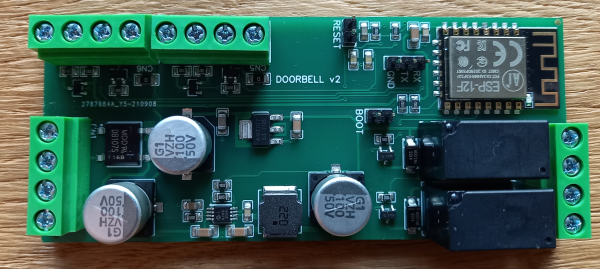Make your cheap doorbell smart
Inspired by https://www.mikrocontroller.net/topic/444994
Big thanks to the guys on mikrocontroller.net, especially Jürgen. I would never have started this project without your work on the SIP part.
USE AT YOUR OWN RISK!
This repo contains the pcb files as well as the software to build an interface device which makes cheap doorbells smart. Just connect the board between your existing bell button and your chime. Depending on the software configuration the button can afterwards ring your phones (via SIP), publish to an MQTT server or just ring your chime as before.
I started this project to get a cheap solution that rings my FRITZ!Fons (just ring no crosstalk) whenever someone presses my doorbell's button. In addition i wanted to integrate the doorbell into my Home Assistant installation to be able to disable the bell when i don't want to be disturbed and get notifications via push messages when i'm away.
Under the following links one can find the configuration description and two example setups:
docs: Documentationdoorbell: Arduino project for ESP8266pcb: Schematic and board files
- Get a pcb
- Supply pcb with a voltage between 8-12V (AC or DC) via pins 1 & 2 of
CN1 - Check if 5V and 3.3V are fine
- Supply pcb with a voltage between 8-12V (AC or DC) via pins 1 & 2 of
- Get tools listed below
- Rename doorbell/config_template.h to doorbell/config.h and adjust to your environment
- Add
esp8266boards to Arduino IDE- Open Preferences window
- Enter http://arduino.esp8266.com/stable/package_esp8266com_index.json into Additional Board Manager URLs field. You can add multiple URLs, separating them with commas.
- Open Boards Manager from Tools > Board menu and find
esp8266platform. - Click install button.
- Select
NodeMCU 1.0 (ESP-12E Module)as board
- Add Libraries to Arduino IDE
- Open Sketch > Include library -> Manage libraries...
- Install
PubSubClient(tested with version 2.8.0) - Install
PubSubClientTools(tested with version 0.6.0)
- First flashing of
esp8266- Get a cheap USB-UART converter (like the ones with a
CP210x) - Connect the converter to
H1(RX, TX and GND) - Short
H3(Boot mode) - Power up board. If board was powered before reset
esp8266by shortingH2(Reset) for a short time
- Get a cheap USB-UART converter (like the ones with a
- EasyEDA
- Arduino IDE 1.8.13
- USB-UART converter
